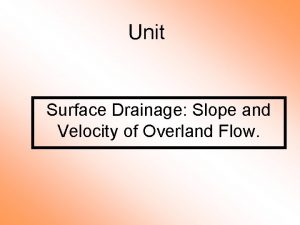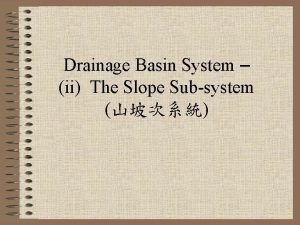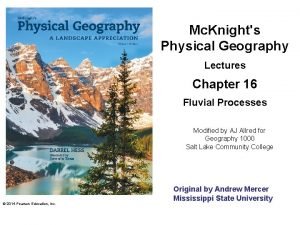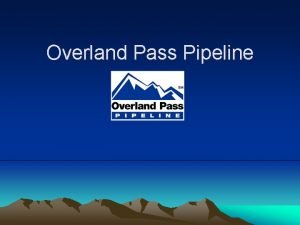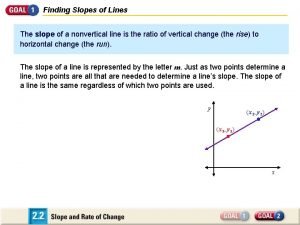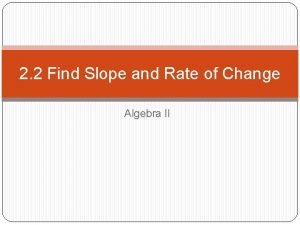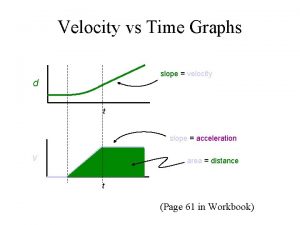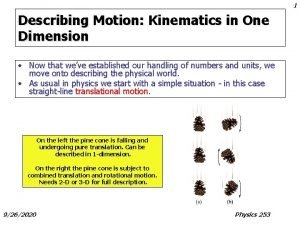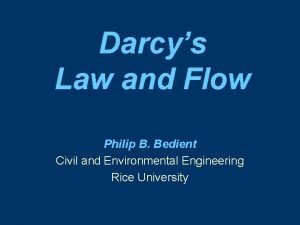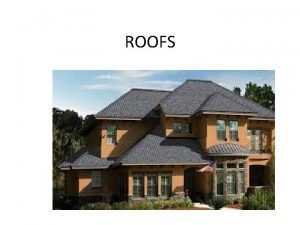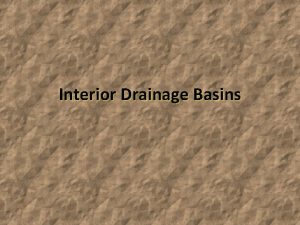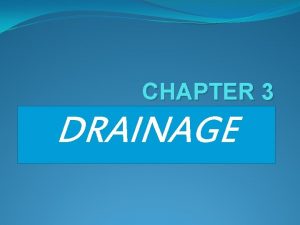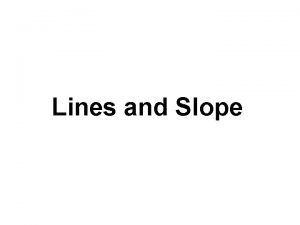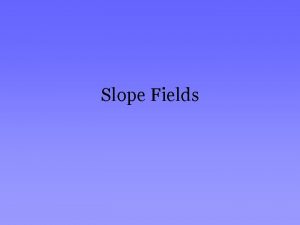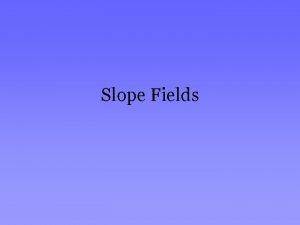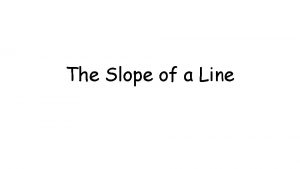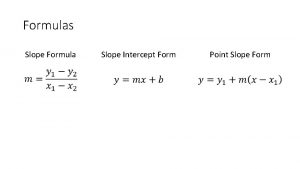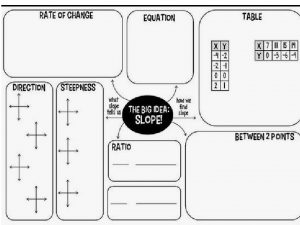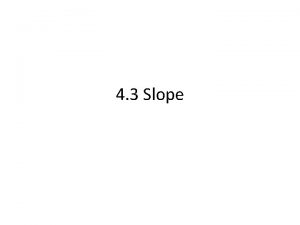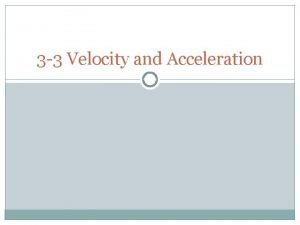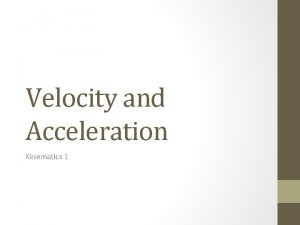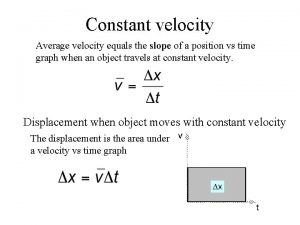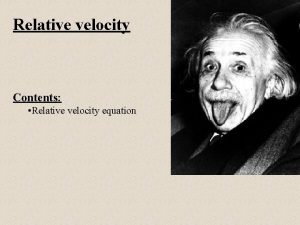Unit Surface Drainage Slope and Velocity of Overland























- Slides: 23

Unit Surface Drainage: Slope and Velocity of Overland Flow.

Objectives 1. Quantify the relationship between slope and velocity. 2. Describe the impact of roughness (friction) on velocity. 3. Make design decisions relative to slope and roughness to control water velocities in surface drains.

Terms Non-linear relationship Runoff Slope Velocity

How does slope affect velocity? - Velocity, distance divided by time, increases at a ratio of v to the square root of the slope.

Velocity - Slope is the amount of rise divided by the amount of run or distance traveled.

Manning’s Equation -can help estimate the velocity of a fluid in a channel with many variables.

What affect does friction have on velocity?

Friction affects. - Friction affects the velocity of water in a channel. - The roughness coefficient determines the speed of the water.

- Winding, sluggish and weedy banks slow water down more than smooth straight channels.

Runoff -is water and soil that travel along the soil surface. - The runoff of a land area is dependent on the infiltration and percolation rates of the soil as well as the precipitation levels.

Runoff - The precipitation levels cannot be controlled. The soil characteristics will change over time, and as erosion increases the soil characteristics will differ.

How can changing slope and friction control water velocity in surface drains?

- The roughness, slope, and velocity of a channel all impact erosion and surface drainage.

-As the roughness of a channel increases the velocity of the water decreases. This forms an indirect relationship.

-Roughness is difficult to change in an existing waterway but can be affected in a newly created waterway situation.

-The velocity of water flowing overland in an open channel varies as the square root of the slope in ft/ft. The relationship is nonlinear.

-Slope is topographical and cannot easily be changed in a large channel but may be altered in smaller channels.

MANNING’S EQUATION

Roughness Coefficient n, for the Manning Formula Lined channels Type and Description of Channel n Value Asphalt Concrete rubble 0. 015 0. 012– 0. 013 0. 017– 0. 030 Smooth metal 0. 011– 0. 015 Corrugated metal 0. 021– 0. 026 Plastic 0. 012– 0. 011 Wood 0. 011– 0. 015

Vegetated Channels* Dense, uniform stands of green vegetation more than 10 in. long Bermuda grass 0. 04– 0. 20 Kudzu 0. 07– 0. 23 Common Lespedeza 0. 047– 0. 095 Dense, uniform stands of green vegetation cut to a length of less than 2. 5 in. Short Bermuda grass 0. 034– 0. 11 Kudzu 0. 045– 0. 16

Earth Channel and Natural Streams Clean, straight bank, full stage 0. 025– 0. 040 Winding, some pools and shoals, clean 0. 035– 0. 055 Winding, some weeds and stones 0. 033– 0. 045 Sluggish river reaches, weedy or with very deep pools 0. 050– 0. 150

Earth Channel and Natural Streams Clean, straight bank, full stage 0. 025– 0. 040 Winding, some weeds and stones 0. 033– 0. 045 Winding, some pools and shoals, clean 0. 035– 0. 055 Sluggish river reaches, weedy 0. 050– 0. 150 or with very deep pools

Pipe Asbestos cement 0. 009 Cast iron 0. 011– 0. 015 Clay or concrete (4– 12 in. ) 0. 010 – 0. 020 Corrugated metal 0. 021– 0. 0255 Corrugated plastic (2– 4 in. ) 0. 016 Riveted and spiral steel 0. 013– 0. 017 Vitrified sewer pipe 0. 010– 0. 017 Wrought iron 0. 012– 0. 017
 Slope of overland surface
Slope of overland surface Free face slope
Free face slope Water cycle inputs
Water cycle inputs Paket wisata overland
Paket wisata overland Overland flow geography definition
Overland flow geography definition Oregon fever apush
Oregon fever apush Whigs apush definition
Whigs apush definition Overland pass pipeline
Overland pass pipeline Relationship between angular and linear quantities
Relationship between angular and linear quantities Initial velocity and final velocity formula
Initial velocity and final velocity formula Constant acceleration speed time graph
Constant acceleration speed time graph Point-slope form definition geometry
Point-slope form definition geometry Slopes of lines
Slopes of lines Slope review classifying slope
Slope review classifying slope Slope of velocity vs time graph
Slope of velocity vs time graph Hydraulic conductivity of soil formula
Hydraulic conductivity of soil formula Is v final velocity
Is v final velocity Instantaneous velocity vs average velocity
Instantaneous velocity vs average velocity Darcy velocity vs actual velocity
Darcy velocity vs actual velocity Tangential speed
Tangential speed Tangential speed
Tangential speed What is mud phuska
What is mud phuska Unit 6 lesson 1 rate of change and slope
Unit 6 lesson 1 rate of change and slope Unit 2 linear functions homework 2
Unit 2 linear functions homework 2
